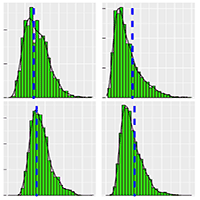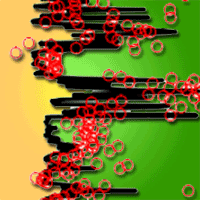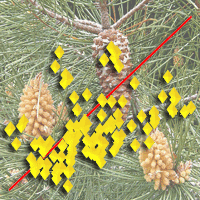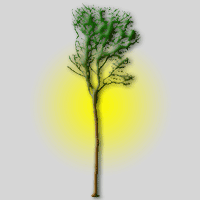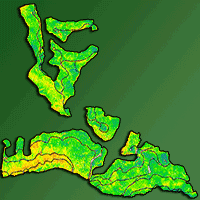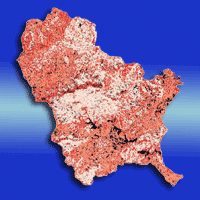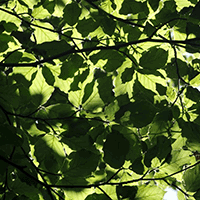Allometric equations relating trees’ vascular system and other stem metrics with foliage area and mass are important to estimate their growth, carbon stocks and interactions with abiotic environment in terms of carbon and water balance. In this study we focused on Robinia pseudoacacia restoration plantations in Greece and aimed at establishing species-specific models to predict foliage leaf area and biomass based on stem traits. In particular, we evaluated stem cross-sectional areas of sapwood, current sapwood and total stem (sapwood and heartwood), measured at different tree heights, as predictors of leaf area and mass, based on the pipe model theory. Furthermore, we assessed the variation in the ratios of leaf area to different stem cross-sectional areas across the tree profile and we examined the relationships of diameter at breast height (DBH) with diameter at the base of the live crown and with leaf area. Taking into account the trees’ DBH distribution according to the plantations’ inventory, 25 black locust individuals were destructively sampled and the relationships among the studied traits were analyzed by means of multiple and simple linear regression at p<0.001. Foliage dry mass and area were best predicted by total stem cross-sectional area at mid-bole and stump height (R2=0.81), followed by current sapwood area at stump height (R2=0.74), which outperformed the most often used sapwood area (R2=0.70). DBH was also reliably estimating tree leaf area (R2=0.72) but was less precise, compared to total cross-sectional area, while it was a useful proxy of diameter at the base of the live crown (R2=0.80). In line with the pipe model theory, the ratio of leaf area to total cross-sectional area declined across the canopy basipetally, but only when total cross-sectional area was considered. Deviations from the sapwood-foliage functions described by the pipe model theory may be due to the small sample size and the variability in tree size in such developing restoration plantations. The produced species-specific relationships between stem and foliage metrics may be a useful tool to predict the carbon sequestration and climate change adaptation potential of black locust restoration plantations, which are often characterized by harsh site conditions.
Keywords
, , , , , , ,
Citation
Tziaferidis SR, Spyroglou G, Fotelli MN, Radoglou K (2022). Allometric models for the estimation of foliage area and biomass from stem metrics in black locust. iForest 15: 281-288. - doi: 10.3832/ifor3939-015
Academic Editor
Giorgio Alberti
Paper history
Received: Jul 30, 2021
Accepted: Jun 01, 2022
First online: Jul 27, 2022
Publication Date: Aug 31, 2022
Publication Time: 1.87 months
© SISEF - The Italian Society of Silviculture and Forest Ecology 2022
Open Access
This article is distributed under the terms of the Creative Commons Attribution-Non Commercial 4.0 International (https://creativecommons.org/licenses/by-nc/4.0/), which permits unrestricted use, distribution, and reproduction in any medium, provided you give appropriate credit to the original author(s) and the source, provide a link to the Creative Commons license, and indicate if changes were made.

Breakdown by View Type
(Waiting for server response...)
Article Usage
Total Article Views: 30470
(from publication date up to now)
Breakdown by View Type
HTML Page Views: 25810
Abstract Page Views: 2724
PDF Downloads: 1520
Citation/Reference Downloads: 0
XML Downloads: 416
Web Metrics
Days since publication: 1254
Overall contacts: 30470
Avg. contacts per week: 170.09
Article Citations
Article citations are based on data periodically collected from the Clarivate Web of Science web site
(last update: Mar 2025)
Total number of cites (since 2022): 5
Average cites per year: 1.25
Publication Metrics
by Dimensions ©
Articles citing this article
List of the papers citing this article based on CrossRef Cited-by.
(1)
Anfodillo T, Petit G, Crivellaro A (2013)Axial conduit widening in woody species: a still neglected anatomical pattern. IAWA Journal 34: 352-364.
CrossRef |
Gscholar
(2)
Annighöfer P, Mölder I, Zerbe S, Kawaletz H, Terwei A, Ammer C (2012)Biomass functions for the two alien species
Prunus serotine Ehrh. and
Robinia pseudoacacia L. in floodplain forests of Northern Italy. European Journal of Forest Research 131: 1619-1635.
CrossRef |
Gscholar
(3)
Baldocchi DD, Wilson KB, Gu L (2002)How the environment, canopy structure and canopy physiological functioning influence carbon, water and energy fluxes of a temperate broad-leaved deciduous forest an assessment with the biophysical model CANOAK. Tree Physiology 22: 1065-1077.
CrossRef |
Gscholar
(4)
Bartelink HH (1997)Allometric relationships for biomass and leaf area of beech (
Fagus sylvatica L). Annals of Forest Science 54: 39-50.
CrossRef |
Gscholar
(5)
Blanchard E, Birnbaum P, Ibanez T, Boutreux T, Antin C, Ploton P, Vincent G, Pouteau R, Vandrot H, Hequet V, Barbier N, Droissart V, Sonké B, Texier N, Kamdem N, Zebaze D, Libalah M, Couteron P (2016)Contrasted allometries between stem diameter, crown area, and tree height in five tropical biogeographic areas. Trees 30: 1953-1968.
CrossRef |
Gscholar
(6)
Böhm C, Quinkenstein A, Freese D (2011)Yield prediction of young black locust (
Robinia pseudoacacia L.) plantations for woody biomass production using allometric relations. Annals of Forest Research 54: 215-227.
Online |
Gscholar
(7)
Caldwell BT, O’Hara KL (2017)Correlation of leaf area index to root biomass in
Populus tremuloides Michx supports the pipe model theory. Journal of Biodiversity Management and Forestry 6: 4.
CrossRef |
Gscholar
(8)
Carl C, Biber P, Landgraf D, Buras A, Pretzsch H (2017)Allometric models to predict aboveground woody biomass of Black locust (
Robinia pseudoacacia L.) in short rotation coppice in previous mining and agricultural areas in Germany. Forests 8: 328.
CrossRef |
Gscholar
(9)
Chave J, Réjou-Méchain M, Búrquez A, Chidumayo E, Colgan MS, Delitti WB, Duque A, Eid T, Fearnside PM, Goodman RC, Henry M, Martínez-Yrízar A, Mugasha WA, Muller-Landau HC, Mencuccini M, Nelson BW, Ngomanda A, Nogueira EM, Ortiz-Malavassi E, Pélissier R, Ploton P, Ryan CM, Saldarriaga JG, Vieilledent G (2014)Improved allometric models to estimate the aboveground biomass of tropical trees. Global Change Biology 20: 3177-3190.
CrossRef |
Gscholar
(10)
Cienciala E, Cerny M, Tatarinov F, Apltauer J, Exnerová Z (2006)Biomass functions applicable to Scots pine. Trees 20: 483-495.
CrossRef |
Gscholar
(11)
Cierjacks A, Kowarik I, Joshi J, Hempel S, Ristow M, Der Lippe MV, Weber E (2013)Biological flora of the British Isles:
Robinia pseudoacacia. Journal of Ecology 101: 1623-1640.
CrossRef |
Gscholar
(12)
Chojnacky DC, Heath LS, Jenkins JC (2014)Updated generalized biomass equations for North American tree species. Forestry 87: 129-151.
CrossRef |
Gscholar
(13)
Cruickshank MG, Cameron IR, Groot A, Stewart JD, Goudie JW (2015)Models of the vertical distribution of sapwood area for lodgepole pine and western hemlock in western Canada. Forest Science 61: 973-987.
CrossRef |
Gscholar
(14)
Cunliffe AM, McIntire CD, Boschetti F, Sauer KJ, Litvak M, Anderson K, Brazier RE (2020)Allometric relationships for predicting aboveground biomass and sapwood area of Oneseed Juniper (
Juniperus monosperma) trees. Frontiers in Plant Science 11: 94.
CrossRef |
Gscholar
(15)
DeGomez T, Wagner MR (2001)Culture and use of black locust. HortTechology 2: 279-288.
CrossRef |
Gscholar
(16)
Delzon S, Sartore M, Burlett R, Dewar R, Loustau D (2004)Hydraulic responses to height growth in maritime pine trees. Plant Cell and Environment 27: 1077-1087.
CrossRef |
Gscholar
(17)
Duncanson L, Rourke O, Dubayah R (2015)Small sample sizes yield biased allometric equations in temperate forests. Scientific Reports 5: 17153.
CrossRef |
Gscholar
(18)
Duncanson L, Huang W, Johnson K, Swatantran A, McRoberts RE, Dubayah R (2017)Implications of allometric model selection for county-level biomass mapping. Carbon Balance and Management 12: 18.
CrossRef |
Gscholar
(19)
Gajardo-Caviedes PA, Espinoza MA, González UT, Rios DG (2005)The influence of thinning and tree size on the sapwood area / leaf area ratio in coigue. Canadian Journal of Botany 35: 1679-1685.
CrossRef |
Gscholar
(20)
Goude M, Nilsson U, Holmström E (2019)Comparing direct and indirect leaf area measurements for Scots pine and Norway spruce plantations in Sweden. European Journal of Forest Research 138: 1033-1047.
CrossRef |
Gscholar
(21)
Grote R (2003)Estimation of crown radii and crown projection area from stem size and tree position. Annals of Forest Science 60: 393-402.
CrossRef |
Gscholar
(22)
Grünewald H, Böhm C, Quinkenstein A, Grundmann P, Eberts J, Von Wühlisch G (2009)Robinia pseudoacacia L.: a lesser known tree species for biomass production. Bioenergy Research 2: 123-133.
CrossRef |
Gscholar
(23)
Kou M, Garcia-Fayos P, Hu S, Jiao J (2016)The effect of
Robinia pseudoacacia afforestation on soil and vegetation properties in the Loess Plateau (China): a chronosequence approach. Forest Ecology and Management 375: 146-158.
CrossRef |
Gscholar
(24)
Larjavaara M, Muller-Landau HC (2010)Rethinking the value of high wood density. Functional Ecology 24: 701-705.
CrossRef |
Gscholar
(25)
Lehnebach R, Beyer R, Letort V, Heuret P (2018)The pipe model theory half a century on: a review. Annals of Botany 121: 773-795.
CrossRef |
Gscholar
(26)
Lehsten V (2005)LAFORE - Leaf Area FOR Everyone: calculating leaf area, leaf width and length from ordinary scans. University of Oldenburg, Germany, web site.
Online |
Gscholar
(27)
Liu Z, Hu B, Bell TL, Flemetakis E, Rennenberg H (2020)Significance of mycorrhizal associations for the performance of N
2-fixing Black locust (
Robinia pseudoacacia L.). Soil Biology and Biochemistry 145: 107776.
CrossRef |
Gscholar
(28)
Lockhart BR, Weih Jr RC, Smith KM (2005)Crown radius and diameter at breast height relationships for six bottomland hardwood species. Journal of the Arkansas Academy of Science 59: 110-115.
Online |
Gscholar
(29)
Marchand PJ (1984)Sapwood area as an estimator of foliage biomass and projected leaf area for
Abies balsamea and
Picea rubens. Canadian Journal of Forest Research 14: 85-87.
CrossRef |
Gscholar
(30)
McDowell N, Barnard H, Bond B, Hinckley T, Hubbard R, Ishii H, Köstner B, Magnani F, Marshall J, Meinzer F, Phillips N, Ryan M, Whitehead D (2002)The relationship between tree height and leaf area: sapwood area ratio. Oecologia 132: 12-20.
CrossRef |
Gscholar
(31)
Meadows JS, Hodges JD (2002)Sapwood area as an estimator of leaf area and foliar weight in cherrybark oak and green ash. Forest Science 48: 69-76.
Online |
Gscholar
(32)
Medhurst JL, Beadle CL (2002)Sapwood hydraulic conductivity and leaf area - sapwood area relationships following thinning of a
Eucalyptus nitens plantation. Plant, Cell and Environment 25: 1011-1019.
CrossRef |
Gscholar
(33)
Mercurio R (2018)What does forest restoration mean in Italy? Journal of Mediterranean Ecology 16: 27-36.
Online |
Gscholar
(34)
Morataya R, Galloway G, Berninger F, Kanninen M (1999)Foliage biomass - sapwood (area and volume) relationships of
Tectona grandis L.f. and
Gmelina arborea Roxb.: silvicultural implications. Forest Ecology and Management 113: 231-239.
CrossRef |
Gscholar
(35)
Moser A, Rötzer T, Pauleit S, Pretzsch H (2015)Structure and ecosystem services of small-leaved lime (
Tilia cordata Mill.) and black locust (
Robinia pseudoacacia L.) in urban environments. Urban Forestry and Urban Greening 14: 1110-1121.
CrossRef |
Gscholar
(36)
Nicolescu VN, Rédei K, Mason WL, Vor T, Pöetzelsberger E, Bastien JC, Brus R, Benčat T, Dodan M, Cvjetkovic B, Andrašev S, La Porta N, Lavnyy V, Mandzukovski D, Petkona K, Rozenbergar D, Wasik R, Mohren GMJ, Monteverdi MC, Musch B, Klisz M, Perić S, Keca L, Bartlett D, Hernea C, Pástor M (2020)Ecology, growth and management of black locust (
Robinia pseudoacacia L.), a non-native species integrated into European forests. Journal of Forestry Research 31: 1081-1101.
CrossRef |
Gscholar
(37)
Nola P, Bracco F, Assini S, Von Arx G, Castagneri D (2020)Xylem anatomy of
Robinia pseudoacacia L. and
Quercus robur L. is differently affected by climate in a temperate alluvial forest. Annals of Forest Science 77: 8.
CrossRef |
Gscholar
(38)
Ogawa K (2015)Mathematical consideration of the pipe model theory in woody plant species. Trees 29: 695-704.
CrossRef |
Gscholar
(39)
Petersen KS, Ares A, Terry TA, Harisson RB (2008)Vegetation competition effects on aboveground biomass and macronutrients, leaf area, and crown structure in 5-year old Douglas-fir. New Forests 35: 299-311.
CrossRef |
Gscholar
(40)
Petit G, Von Arx G, Kiorapostolou N, Lechthaler S, Prendin AL, Anfodillo T, Caldeira MC, Cochard H, Copini P, Crivellaro A, Delzon S, Gebauer R, Gričar J, Grönholm L, Hölttä T, Jyske T, Lavrič M, Lintunen A, Lobo-Do-Vale R, Peltoniemi M, Peters RL, Robert EMR, Roig Juan S, Senfeldr M, Steppe K, Urban J, Van Camp J, Sterck F (2018)Tree differences in primary and secondary growth drive convergent scaling in leaf area to sapwood area across Europe. New Phytologist 218: 1383-1392.
CrossRef |
Gscholar
(41)
Phillips N, Bond BJ, McDowell NG, Ryan MG, Schauer A (2003)Leaf area compounds height-related hydraulic costs of water transport in Oregon White Oak trees. Functional Ecology 17: 832-840.
CrossRef |
Gscholar
(42)
Pretzsch H, Dieler J (2012)Evidence of variant intra- and interspecific scaling of tree crown structure and relevance for allometric theory. Oecologia 169: 637-649.
CrossRef |
Gscholar
(43)
R Development Core Team (2014)R: a language and environment for statistical computing. R Foundation for Statistical Computing, Vienna, Austria. R Foundation for Statistical Computing, Vienna.
Online |
Gscholar
(44)
Rédei K, Bakti B, Kiss T, Takács M, Keseru Z (2018)Yield and crown structure characteristics in a black locust (
Robinia pseudoacacia L.) stand: a case study. Journal of Forest Science 64: 96-100.
CrossRef |
Gscholar
(45)
Reyes-García C, Andrade J, Simá JL, Us-Santamaría R, Jackson P (2012)Sapwood to heartwood ratio affects whole-tree water use in dry forest legume and non-legume trees. Trees 26: 1317-1330.
CrossRef |
Gscholar
(46)
Schneider R, Berninger F, Ung C-H, Mäkelä A, Swift DE, Zhang SY, Whitehead D (2011)Within crown variation in the relationship between foliage biomass and sapwood area in jack pine. Tree Physiology 31: 22-29.
CrossRef |
Gscholar
(47)
Schneider CA, Rasband WS, Eliceiri KW (2012)NIH Image to ImageJ: 25 years of image analysis. Nature Methods 9: 671-675.
CrossRef |
Gscholar
(48)
Sellin A, Kupper P (2006)Spatial variation in sapwood area to leaf area ratio and specific leaf area within a crown of silver birch. Trees 20: 311-319.
CrossRef |
Gscholar
(49)
Shinozaki K, Yoda K, Hozumi K, Kira T (1964a)A quantitative analysis of plant form - the pipe model theory I. Basic analyses. Japanese Journal of Ecology 14: 97-132.
Gscholar
(50)
Shinozaki K, Yoda K, Hozumi K, Kira T (1964b)A quantitative analysis of plant form -the pipe model theory II. Further evidence of the theory and its application in forest ecology. Japanese Journal of Ecology 14: 133-139.
Gscholar
(51)
Shingleton A (2010)Allometry: the study of biological scaling. Nature Education Knowledge 3: 2.
Gscholar
(52)
Sirri NF, Libalah MB, Momo Takoudjou S, Ploton P, Medjibe V, Kamdem NG, Mofack G, Sonké B, Barbier N (2019)Allometric models to estimate leaf area for tropical African broadleaved forests. Geophysical Research Letters 46: 8985-8994.
CrossRef |
Gscholar
(53)
Spyroglou G, Zianis D, Koleta I, Radoglou K (2019)Leaf area and foliage weight to sapwood area models for
Quercus frainetto (TEN) in Greece. Silva Balcanica 20: 5-20. -
Online |
Gscholar
(54)
Spyroglou G, Fotelli M, Nanos N, Radoglou K (2021)Assessing black locust biomass accumulation in restoration plantations. Forests 12: 1477.
CrossRef |
Gscholar
(55)
Sumida A, Nakai T, Yamada M, Ono K, Uemura S, Hara T (2009)Ground-based estimation of leaf area index and vertical distribution of leaf area density in a
Betula ermanii forest. Silva Fennica 43: 799-816.
CrossRef |
Gscholar
(56)
Sumida A, Miyaura T, Torii H (2013)Relationships of tree height and diameter at breast height revisited: analyses of stem growth using 20-year data of an even-aged
Chamaecyparis obtusa stand. Tree Physiology 33: 106-118.
CrossRef |
Gscholar
(57)
Tyree MT, Ewers FW (1991)The hydraulic architecture of trees and other woody plants. Tansley review no. 34. New Phytologist 119: 345-360.
CrossRef |
Gscholar
(58)
Vertessy RA, Benyon RG, O’Sullivan SK, Gribben PR (1995)Relationship between stem diameter, sapwood area, leaf area and transpiration in a young mountain ash forest. Tree Physiology 15: 559-568.
CrossRef |
Gscholar
(59)
Vítková M, Mullerova J, Sadlo J, Pergl J, Pysek P (2017)Black locust (
Robinia pseudoacacia) beloved and despised: a story of an invasive tree in Central Europe. Forest Ecology and Management 38: 287-302.
CrossRef |
Gscholar
(60)
White DA (1993)Relationships between foliar number and the cross-sectional areas of sapwood and annual rings in red oak (
Quercus rubra) crowns. Canadian Journal of Forest Research 23: 1245-1251.
CrossRef |
Gscholar
